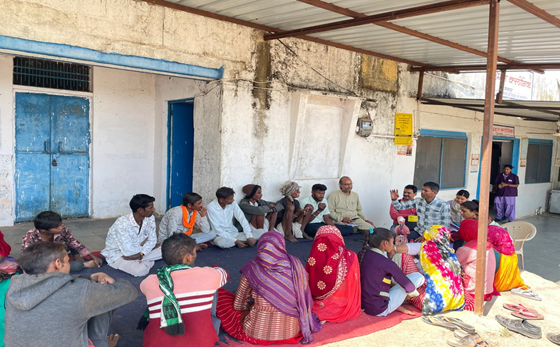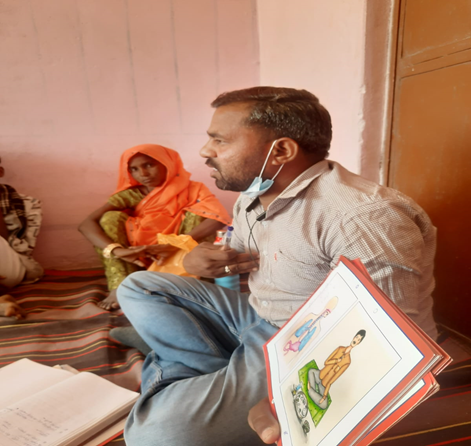Many patients with a range of illnesses walk into our Amrit clinics (rural primary care clinics in tribal south Rajasthan), sharing that they have received cautionary food advice from their traditional healers (‘bhopas’), unqualified providers (often known as ‘Bengalis’), and even qualified doctors at Primary Health Centers (PHCs). They are desperate to find out if it is okay to consume certain foods. The most common piece of advice is to avoid ‘khaati chaach’ or sour buttermilk.
Earlier, when I heard a few patients asking if it was okay for them to consume chaach, I found it peculiar and wondered about the genesis of this question and if there was actually some substance to it. When I later heard our Community Health Workers (CHWs) counseling TB patients, emphasizing that the patient can eat everything, including khaati chaach, it became clear to me that there is, in fact, no reason for the patient to avoid it.
Often, following the popular advice and narratives of the elderly in the family, many patients remove this dairy product (the only dairy product that is available to them) from their diets. Even this one simple thing, which is easily available, is villainized for reasons unknown, and patients are denied its consumption.
Trying to make sense of this stereotype, I asked Dr. Pavitra, a community health physician who has been working in these communities for a long time. He told me that illness is often ascribed to the wrongdoing of the person herself. Since chaach is tasteful and gives joy, the patient is possibly expected to give it up as a “penance” for wrongdoing. This penance is probably considered essential to recover from the disease. It’s almost like a temptation that one has to overcome in order to get well.
I further reflected on this phenomenon. Many food items in modern society have been villainized simply because they were consumed by the masses. In order to deepen the divide between the masses and the rich, multiple levels of food segregation have been created. How the narratives around gluten and dairy have been blown out of proportion in the cities is a case in point. It has created an unjustifiable demand for products that benefit the big brothers of the food industry. In a somewhat similar way, the stereotype against chaach has harmed the people in our community — the only difference being the food item is eliminated in the case of chaach, whereas it is replaced by a “healthier alternative” in the case of gluten.
Besides being tasteful and nutritious, buttermilk is also an appetizer. People suffering from Tuberculosis, who in any case have suppressed appetite, when also denied buttermilk, are unable to eat much. They are then not able to get enough nutrition and gain weight, which further slows their recovery.
 Other than patients with respiratory diseases, a lot of women in the perinatal group are also advised to avoid consuming chaach during pregnancy. Ramesh ji, who has worked with these communities for many years, told me that families believe chaach goes into the woman’s stomach and sticks to the baby’s head. Similarly, other sticky food items like bhindi, which are slimy in texture, are also not allowed during pregnancy. This brings forth two misconceptions at once: firstly, that it makes the womb slimy, and secondly, the belief that the baby is located in the stomach and not in the uterus (bacche daani). In fact, the uterus and stomach are two different organs altogether and have no anatomical connection. Such beliefs, when echoed by faith healers, become solidified and are diligently followed by people. Often, our CHWs take body models with them to the community and explain the basic anatomy of the human body to address these misconceptions. Addressing stereotypes against these food items has also become an important aspect of diet counseling, but these efforts take time to seep in compared to the age-old and continuous messaging of misinformation.
Other than patients with respiratory diseases, a lot of women in the perinatal group are also advised to avoid consuming chaach during pregnancy. Ramesh ji, who has worked with these communities for many years, told me that families believe chaach goes into the woman’s stomach and sticks to the baby’s head. Similarly, other sticky food items like bhindi, which are slimy in texture, are also not allowed during pregnancy. This brings forth two misconceptions at once: firstly, that it makes the womb slimy, and secondly, the belief that the baby is located in the stomach and not in the uterus (bacche daani). In fact, the uterus and stomach are two different organs altogether and have no anatomical connection. Such beliefs, when echoed by faith healers, become solidified and are diligently followed by people. Often, our CHWs take body models with them to the community and explain the basic anatomy of the human body to address these misconceptions. Addressing stereotypes against these food items has also become an important aspect of diet counseling, but these efforts take time to seep in compared to the age-old and continuous messaging of misinformation.
 I then spoke to Kokila Bai, one of our clinic attendants at Kojawara village, who comes from the same community. She told me that chaach has Vitamin C, and she always advises and corrects people who believe chaach is harmful. She also challenges dietary stereotypes within her family. There are many other workers like her within our team who work every day to promote correct knowledge and dispel myths around chaach and other such fads and beliefs.
I then spoke to Kokila Bai, one of our clinic attendants at Kojawara village, who comes from the same community. She told me that chaach has Vitamin C, and she always advises and corrects people who believe chaach is harmful. She also challenges dietary stereotypes within her family. There are many other workers like her within our team who work every day to promote correct knowledge and dispel myths around chaach and other such fads and beliefs.
By Pratishtha Pal – Executive (Mental Health)
